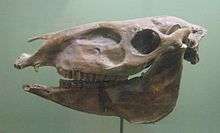Pliohippus
Pliohippus (Greek πλείων (pleion, "more") and ἵππος (ippos, "horse"))[1] is an extinct genus of Equidae, the "horse family". Pliohippus arose in the middle Miocene, around 15 million years ago. The long and slim limbs of Pliohippus reveal a quick-footed steppe animal. While some specimens have one toe per leg, others have three (the main toe and two non-functional side toes).[2]
| Pliohippus Temporal range: Mid Miocene | |
|---|---|
 | |
| Pliohippus pernix skull | |
| Scientific classification | |
| Kingdom: | Animalia |
| Phylum: | Chordata |
| Class: | Mammalia |
| Order: | Perissodactyla |
| Family: | Equidae |
| Subfamily: | Equinae |
| Tribe: | Equini |
| Genus: | †Pliohippus Marsh, 1874 |
Until recently, because of its many anatomical similarities, Pliohippus was believed to be the ancestor of the present-day horse and its relatives in Equus. Although Pliohippus clearly is an equid and thus related to Equus, its skull had deep facial fossae, a feature not found in any member of Equus. Additionally, its teeth were strongly curved, unlike the very straight teeth of modern horses. Consequently, it is unlikely to be the ancestor of the modern horse; instead, it is likely to be the ancestor of Astrohippus.[3] Pliohippus stood approximately 1.25 metres, similar to the modern horse. Also like the modern horse, Pliohippus was a grazer that fed of steppe grasses of the North American plains it inhabited.
Fossils of Pliohippus have been found at many late Miocene localities in Colorado, the Great Plains (Nebraska, including Ashfall Fossil Beds[2] and the Dakotas) and also Canada. Pliohippus has been found beside Neohipparion.
 Specimen at American Museum of Natural History
Specimen at American Museum of Natural History
References
- "Evolution". Equestrian and Horse. Retrieved 15 December 2016.
- Williams, Wendy (2015). The Horse. Toronto, Canada: Harper Collins. p. 118. ISBN 9781443417860.
- MacFadden, B. J. (1984). "Astrohippus and Dinohippus". J. Vert. Paleon. 4(2):273-283.